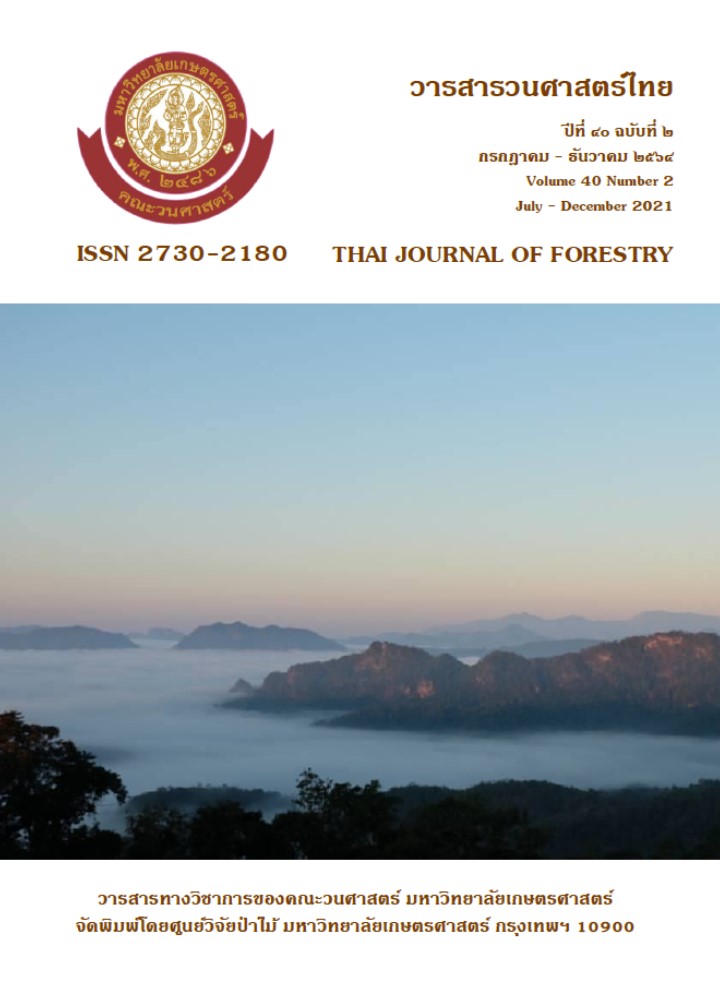การกำหนดเขตเศรษฐกิจไม้สักสำหรับประเทศไทย
Main Article Content
บทคัดย่อ
การศึกษาครั้งนี้มีวัตถุประสงค์เพื่อการวิเคราะห์กำหนดเขตเศรษฐกิจไม้สัก โดยการศึกษาต้นทุนและผลตอบแทนทางเศรษฐศาสตร์ของการปลูกไม้สักรายจังหวัด ภายใต้กรอบระยะเวลาของการวิเคราะห์ 20 ปี โดยใช้ราคาคงที่ (ปีฐาน พ.ศ.2562) อัตราคิดลดเท่ากับร้อยละ 3 โดยมีตัวชี้วัดความคุ้มค่า คือ มูลค่าปัจจุบันสุทธิ (NPV) อัตราส่วนผลประโยชน์ต่อต้นทุน (BCR) และอัตราผลตอบแทนภายใน (IRR) เพื่อใช้ในการกำหนดเขตเศรษฐกิจไม้สักสำหรับการบริหารจัดการการปลูกไม้สักเชิงพาณิชย์ในภาพรวมของประเทศไทย
การวิเคราะห์ต้นทุนและผลตอบแทนทางเศรษฐศาสตร์ของการปลูกไม้สัก เพื่อนำไปสู่การกำหนดเขตเศรษฐกิจไม้สักให้ความสำคัญด้านความแตกต่างของจังหวัดต่างๆ ในด้าน ศักยภาพพื้นที่ มูลค่าที่ดิน และระยะทางขนส่ง ผลการศึกษาพบว่า พื้นที่ที่เหมาะสมเป็นเขตเศรษฐกิจไม้สัก ได้แก่จังหวัดกาญจนบุรี อุทัยธานี พิจิตร กำแพงเพชร เพชรบูรณ์ พิษณุโลก สุโขทัย ตาก อุตรดิตถ์ แพร่ ลำปาง ลำพูน น่าน และพะเยา โดยมีมูลค่าปัจจุบันสุทธิทางเศรษฐกิจ (NPV) ในช่วง 209,744-302,880 บาท/ไร่ การทราบถึงกลุ่มจังหวัดที่มีความเหมาะสมสูงสุดในการปลูกไม้สักจะเป็นประโยชน์กับนักลงทุนและที่สำคัญคือทำให้รัฐบาลกำหนดเขตเศรษฐกิจไม้สักได้ ซึ่งจะนำมาสู่การให้การสนับสนุนในรูปแบบต่าง เช่น โครงข่ายการตลาด ระบบรับรองแหล่งที่มาของไม้สัก การบริการขนส่ง หรือ ความสะดวกด้านกฎหมาย
Downloads
Article Details

อนุญาตภายใต้เงื่อนไข Creative Commons Attribution-NonCommercial-NoDerivatives 4.0 International License.
ข้าพเจ้าและผู้เขียนร่วม (ถ้ามี) ขอรับรองว่า ต้นฉบับที่เสนอมานี้ยังไม่เคยได้รับการตีพิมพ์และไม่ได้อยู่ในระหว่างกระบวนการพิจารณาตีพิมพ์ลงในวารสารหรือสิ่งตีพิมพ์อื่นใด ข้าพเจ้าและผู้เขียนร่วม (ถ้ามี) ยอมรับหลักเกณฑ์และเงื่อนไขการพิจารณาต้นฉบับ ทั้งยินยอมให้กองบรรณาธิการมีสิทธิ์พิจารณาและตรวจแก้ต้นฉบับได้ตามที่เห็นสมควร พร้อมนี้ขอมอบลิขสิทธิ์ผลงานที่ได้รับการตีพิมพ์ให้แก่วารสารวนศาสตร์ คณะวนศาสตร์ มหาวิทยาลัยเกษตรศาสตร์ กรณีมีการฟ้องร้องเรื่องการละเมิดลิขสิทธิ์เกี่ยวกับภาพ กราฟ ข้อความส่วนใดส่วนหนึ่ง หรือ ข้อคิดเห็นที่ปรากฏในผลงาน ให้เป็นความรับผิดชอบของข้าพเจ้าและผู้เขียนร่วม (ถ้ามี) แต่เพียงฝ่ายเดียว และหากข้าพเจ้าและผู้เขียนร่วม (ถ้ามี) ประสงค์ถอนบทความในระหว่างกระบวนการพิจารณาของทางวารสาร ข้าพเจ้าและผู้เขียนร่วม (ถ้ามี) ยินดีรับผิดชอบค่าใช้จ่ายทั้งหมดที่เกิดขึ้นในกระบวนการพิจารณาบทความนั้น”
เอกสารอ้างอิง
Boadway, R. 2006. Principles of cost-benefit analysis. Public Policy Review 2(1): 1-44.
Brander, L. 2015. Guidance Manual on Value Transfer Methods for Ecosystem Services. United Nations Publications, Nairobi.
Faculty of Forestry. 2017. Strategy and Action Plan for Extension of Integrated Economic Trees (2018-2036). Faculty of Forestry, Kasetsart University, Bangkok. (in Thai)
Phusudswang, A. 2010. Teak Plantation and Management as Economy for Farmer and Private Sector. Royal Forest Department, Bangkok. (in Thai)
Pradit, O. 2010. Economic feasibility of teak plantation by small farmer in Chiang Mai province. Journal of Agriculture 27(special): 163-172. (in Thai)
Rasmussen, S. 2010. Production Economics: The Basic Theory of Production Optimisation. Springer-Verlag Berlin Heidelberg, Berlin.
Sommeechai, M., K. Tangkit, P. Siripant, K. Prasertsit, K. Thaweesaksri, R. Prancharoung and A. Rodsaen. 2019. Guide Economic Trees Plantation. Royal Forest Department, Bangkok. (in Thai)
Sripraram, D., L. Puangchit, S. Diloksumpun, S. Teejuntuk, N. Jumwong, L. Thaopimai and T. Sangthong. 2010. Characterization of Plants Optimal Greenhouse Gas Absorption and Area Size for Forest Sector Clean Development Mechanism: Complete Report. Faculty of Forestry, Kasetsart University and Thailand Greenhouse Gas Management Organization (Public Organization). Bangkok. (in Thai)
Vacharankura, T., I. Satoshi, I. Noda, W. Himmapan, V. Krongkitsiri and D. Kamolpanit. 2011. Yield Table for Teak Plantation in The Northeast of Thailand. RFD-JIRCAS Joint Research Project. Bangkok. (in Thai)
Vacharankura, T., W. Himmapan, P. Rupporn and J. Noreewech. 2015. Guide for Commercial Thinning. Keawjawjom Printing & Publishing Suan Sunandha Rajabhat University, Bangkok. (in Thai)
Viriyabancha, C. and C. Wachrinrat. 2013. Thai Teak Knowledge. Royal Forest Department, Bangkok. (in Thai)
Viriyabancha, C., P. Chittachumnonk, C. Sutthisrisinn, S. Sumrann and K. Peawsa-ad. 2002. Adjusting equation to estimate the above-ground biomass of Teak plantation in Thailand, pp 239-260. In P. Chittachumnonk, ed. Proceeding of 7th Silvicultural Seminar. December 12-14, 2001. Kasetsart University, Bangkok. (in Thai)


